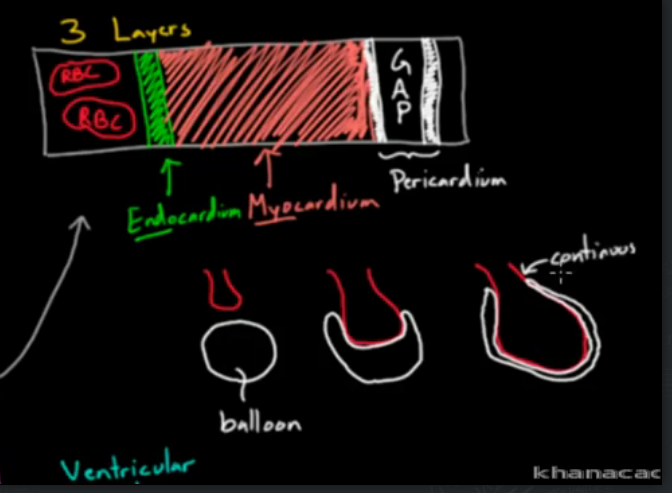Now you may be wondering
大家可能要問
'How on the world do you get a layer that has a gap within it?'
為什么會存在一個間隙呢?
So let me actually try to show you what happens in a fetus.
我來畫一下胚胎的情況
Let's say you have a little fetus heart,a tiny little heart like this.
假設這是胚胎的心臟,這時候心臟非常小
It gets a little bit bigger, like this.
然后慢慢長大
And finally it gets into an adult heart, something like that.
最后這是成人的心臟
This would be the adult heart, right?
這是成人的心臟大小
Well, at the same time that the heart is growing,
那么,隨著心臟長大
you also have a sac, almost like a balloon. Right?
這里會形成一個囊腔,就像一個氣球

This balloon actually begins to envelope the heart.
這個囊腔把心臟包圍起來
This growing heart kind of grows right into the balloon.
心臟在氣球狀的膜內生長
This balloon starts going around it, like that.
膜把心臟包圍起來
And you get something like this.
就像這樣
Eventually, as the heart gets really big, you get something like this.
最后,當心臟成型之后,就變成了這樣
You basically have this kind of inner layer of the balloon that's pancake dot.
氣球內層
It doesn't even look like a balloon anymore. It's very flat.
不再像氣球了,而是變平了
Then it folds back on itself, like that, and it comes all the way around.
然后自己向后翻折,像這樣全部包裹起來
Now you can see why- even though it's continuous,
大家可以看到,這是連續的膜
I mean, it's not like it breaks, it is continuous here,
膜本身并沒有破損
you can see how, if you actually just were to look at at chunk of it,
如果大家看其中的一部分
like we're looking at right here, you could see how it would look like a pancake.
比方說這里,大家會看到,這就像一張薄餅
On our heart it actually- it literally would be something like this, like a very thin kind of pancake.
而心臟就像這樣,非常像一張薄餅
And I'm not doing a very very good job making it look thin,
我畫的不是太薄
but you can imagine what it is,
大家想象一下就可以了
that it could look like if I were to zoom in on it, basically something like that,
如果我們放大來看的話,這里就像這樣
where you have two layers that are basically just kind of turned in on themselves.
兩層膜就像這樣
Both layers put together are called your pericardium.
這兩層膜就叫做心包膜
There are actually separate names for the two layers.
實際上,兩層膜分別有自己的名字
For example, the layer that's kind of hugging up against the heart,
包圍心臟的這層膜
this layer that I'm drawing now, this layer is called the visceral pericardium.
也就是我在畫的這層,這個叫做心外膜
So you call that the visceral pericardium.
這層是心外膜
The name visceral, this right here would be visceral,
這是心外膜
the reason it's called visceral is because viscero- means organs.
前綴viscero-意思是內臟
So that's called the visceral pericardium.
這層膜叫心外膜
This outer layer, the one I'm drawing now, is called the parietal pericardium.
而這外邊的一層是心包壁層
That's the layer that actually is on the outside.
也就是在心臟外層的這層
Let me label that as well. So that's this guy.
我標一下,這是心包壁層
That would be the parietal pericardium.
這是心包壁層
Now you can actually see the layers of the heart, the endocardium, myocardium and pericardium.
大家現在可以看到心臟的層次結構了,分為心內膜,心肌層,心包膜
And actually just to throw you a curveball, becasue I'm pretty sure you can handle it,
再給大家出個題目,相信大家能夠解答
this visceral pericardium, another name for it, just because you might see it sometime, is the epicardium.
大家可能會看到,心外膜有別的術語名稱叫epicardium(心外膜)
Sometimes you might see it, the epicardium.
大家可能會遇到
Don't get thrown off; it's really just the visceral pericardium.
不要混淆,這就是心外膜
It's just the outermost layer of that heart before you get to the parietal layer.
指的就是除了心包壁層以外,心臟最外面的一層











